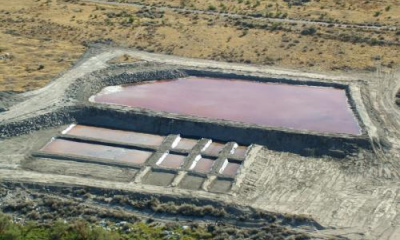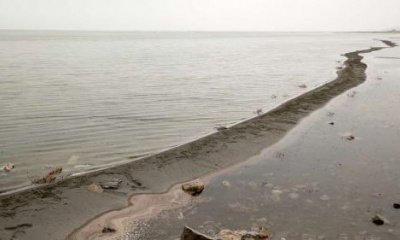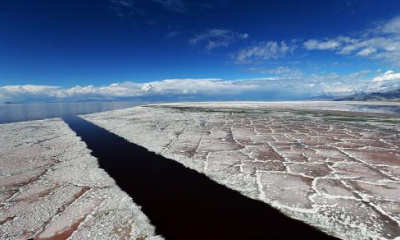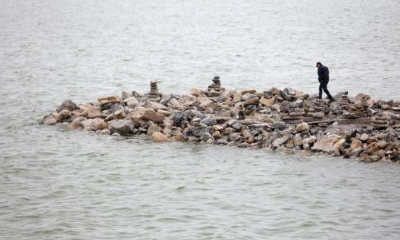A proposed miner claims it will use no evaporation ponds and deplete no water, occupying a significantly smaller footprint than other extractors on the lakebed.
The lithium bonanza continues at the largest saline system in the West, but a new company says it can harvest the mineral in a way that doesn’t contribute to ecological collapse.
Waterleaf Resources, a subsidiary of California-based Lilac Solutions, wants to siphon an astounding 225,000 acre-feet from Utah’s Great Salt Lake, asserting it will pump all the water back after removing its lithium.
The company uses an ion exchange technology developed at Northwestern University that washes brine through bead structures which absorb the lithium minerals and flush out the rest of the water and its remaining minerals.
Unlike other extractors operating on the over-tapped lake, which sunk to another record low last year, Lilac Solutions’ technology does not evaporate water away. It does not need massive ponds that cover thousands of acres across the lakebed and shoreline. It does not create piles of waste or polluting emissions. It’s also new and largely untested.
“We think we can do this without evaporating anything,” said Raef Sully, chief operating officer for Lilac Solutions, “and putting the same volume back that we take out.”
The company wants to undergo a pilot project first, to prove its method works at the Great Salt Lake. Once fully operational, Sully estimates Lilac’s lithium plant would occupy around 25 acres, versus the 55,000-acre solar pond complex used by Compass Minerals, which is currently ramping up its operation to produce lithium as well.
Sully expects the Waterleaf plant will produce up to 25,000 tons of battery-grade lithium each year.
The company filed an application with the Division of Water Rights in July to appropriate the equivalent of 73 billion gallons from the Great Salt Lake annually. That’s enough water to support nearly a half million conservation-minded households in the West.
Gov. Spencer Cox paused the issuance of any new water rights in the Great Salt Lake basin last year. But Lilac Solutions notes in the application that its request is for non-consumptive use, an exception the governor carved out in his order. The company adds it will also file a separate change application to deliver additional mitigation water “as part of its desire to contribute to the enhancement of the Great Salt Lake.”
Sully said the mitigation water will offset any consumptive use of freshwater, which it uses to flush its lithium-bonding beads after processing salty lake water. Waterleaf and Lilac solutions already secured that freshwater via agreements to lease land for its plant, the COO said.
“It’s orders of magnitude less” than the water sought from the Great Salt Lake, Sully said. “The net [result] of that is a slightly larger amount of water going back into the lake than we extract.”
The water rights application indicates the operation will be based somewhere on the Promontory Point peninsula, on the lake’s saltier north arm.
A spokesperson with the Department of Natural Resources (DNR) and Division of Water Rights confirmed the governor’s prohibition on new filings includes exceptions for non-consumptive use and plans that include water to mitigate depletions. The division has not made a decision on the Waterleaf request.
The company’s water right application has received two protests from Utahns wondering why a private business should be allowed to use so much from the lake when farmers and cities have made significant cuts to save it.
The reason the Waterleaf outfit requires all that water, Sully said, is because the concentrations at the Great Salt Lake are relatively small — 50 parts per million versus 1,000 parts per million or more found in brines harvested in South America, where Lilac is also testing its technology.
“The benefit, of course, is that (Great Salt Lake) is in North America,” Sully said. “It would provide jobs, and I believe we can do it in a way that doesn’t cause too much disturbance to the environment.”
The company landed a $50 million grant from the U.S. Department of Energy in 2022 to demonstrate it can produce a domestic lithium supply. Sully said he’d like to launch a pilot on the Great Salt Lake within the next 12 to 18 months.
Demand for lithium has surged both in the United States and abroad as nations look to electrify their grids and transportation systems in an effort to curb human-fueled climate change.
“What we would like to do is be part of an energy transition away from fossil fuels,” Sully said. “But to get that lithium, there are concerns about how it’s done today and the environmental footprint it has. We’d like to think our technology has the opportunity to reduce that dramatically.”
Harvesters currently operating on the Great Salt Lake are also looking to cash in on the lithium frenzy. US Magnesium has a temporary agreement in place with DNR to harvest the material from its existing waste piles. And Kansas-based Compass Minerals, which has operations throughout the world, has retooled its business strategy with a big focus on lithium.
But mineral extractors have drawn intense scrutiny from Utah lawmakers and resource managers as the Great Salt Lake continues to shrivel, with its toxic dust blowing into the lungs of millions living on the Wasatch Front and its ecosystem on the brink of collapse.
Last year, the Department of Environmental Quality denied US Magnesium’s request to extend its canals and continue pumping from the desiccated lake. This year, the Legislature passed HB513. The bill tasks DNR with developing a new royalty structure for minerals like lithium and requires extractors to use methods that minimize water depletion.
“A process will be in place for them to prove up these technologies before they get an agreement for extraction,” said Ben Stireman, deputy director of lands and minerals for the Utah Division of Forestry, Fire and State Lands.
Stireman confirmed his division has had talks with Lilac Solutions.
“The state is in a position where we would not support developing lithium out of Great Salt Lake if it’s at the expense of the lake,” he said.
Lawmakers expressed irritation last month with mineral extractors after Compass Minerals inked a deal with Ford Motor Company to supply lithium from its Great Salt Lake plant, before the state had any of its rules and regulations in place for the commodity. They have signaled more legislation is in the works, including caps on how much material companies can pull from the lake and how much water they can deplete.
Lilac Solutions expects the amount of lithium it mines will get replenished from the sediments washed in by the Great Salt Lake’s tributary rivers each year, Sully said.
“Legislators in Utah should be thinking about restricting any further use of evaporative methods,” the COO added. “There’s a lot of noise in the public about it. And that’s justified.”








